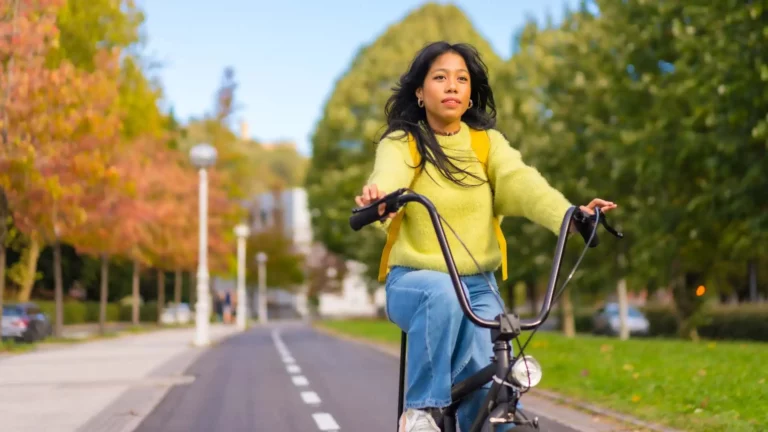Table of Contents
Walk through any city on a Monday morning, and you’ll see the quiet leak that drains most paychecks, which is commuting. Whether it’s gas, parking, or transit passes, the average American spends over $5,000 a year just getting to work. Yet most of us treat it as a fixed cost, not a flexible one.
The truth? Commuting is one of the most hackable expenses in your budget. With a little creativity and planning, you can blend modes like driving partway, cycling the rest, sharing rides, or time-shifting your trips, and cut hundreds (or even thousands) of miles without sacrificing convenience.
Here’s how mode-mixing, the art of combining multiple transport types smartly, can reshape your financial flow and free up serious cash.
The New Economics of Commuting
Commuting costs don’t just come from fuel or fares. They’re layered with hidden expenses, like maintenance, depreciation, time, and even mental fatigue.
Let’s break it down:
- Driving: Gas, parking, insurance, wear and tear – roughly $0.70 per mile driven.
- Public transit: Predictable but rigid; monthly passes range $75–$150 depending on the city.
- Ridesharing: Convenient, but at $10–$20 per ride, the costs add up quickly.
- Cycling or walking: Practically free after setup, but not always feasible on a full-time basis.
Most commuters default to one mode, but that’s like investing your entire paycheck in one stock. Smart savers diversify their commute.
Read related blog: Car Insurance for Rideshare and Delivery: Endorsements You Actually Need
What Is Mode-Mixing (and Why It Works)?
Mode-mixing refers to combining two or more transportation methods to minimize both cost and effort. For instance:
- Drive halfway, park for free, and take a cheap bus or train the rest of the way.
- Bike to a nearby station and complete your journey with public transit.
- Use rideshare one way, carpool the other.
- Alternate between remote workdays and shared commutes.
The power of mode-mixing lies in flexibility, using the cheapest option when it makes sense and switching when it doesn’t. It turns fixed expenses into variables you can control. Think of it as “multi-modal budgeting” for your mobility.
Step 1: Audit Your Commute Like a CFO
Before optimizing, you need visibility.
- Track your true cost. Add up gas, parking, tolls, maintenance, and depreciation (roughly 10¢ per mile).
- Time is money. Estimate your hourly rate. A 20-minute detour for cheaper parking may not actually save you time if it costs you an hour a week.
When you see the leaks, you can start plugging them.
Step 2: Mix, Match, and Multiply Savings
Here’s how different mode mixes can transform your monthly spending:
A. Drive + Transit Hybrid
- Best suited for: Suburban workers commuting into dense downtown areas.
- Strategy: Park near a cheap or free suburban transit stop, then take the train or metro the rest of the way.
- Savings: $100–$250/month on parking and gas.
- Bonus: Less vehicle wear means a longer lifespan before your next major repair is needed.
B. Bike + Bus Combo
- Best for: 5–10 mile urban commutes.
- Strategy: Use a folding or e-bike to reach bus or train lines. Most transit systems now allow bikes on board.
- Savings: Up to $1,500/year compared to driving daily.
- Bonus: Health ROI — fewer gym costs, more energy.
C. Carpool + Remote Mix
- Best for: Flexible work schedules.
- Strategy: Coordinate carpools for 2–3 in-office days and remote work for the rest.
- Savings: $200–$400/month, depending on gas and toll splits.
- Bonus: Fewer miles = lower insurance premiums over time.
D. Transit + Rideshare Backup
- Best for: Weather-dependent commuters.
- Strategy: Use public transportation as the default and ride-share only when necessary.
- Savings: 50%+ reduction in total monthly spend.
- Bonus: Predictable budgeting — one splurge doesn’t offset your entire week.
Mode-mixing thrives on adaptability, not routine.
Read related blog: Teen Driver Add-On vs Separate Policy: Cost, Risks, and Savings Hacks
Step 3: Timing Your Commute for Maximum Efficiency
Even when your mode stays the same, timing can slash costs.
- Off-peak transit discounts: Many cities offer 20–30% lower fares outside rush hour.
- Cheaper gas days: Research shows Tuesday and Wednesday mornings often have the lowest pump prices.
- Dynamic toll avoidance: Use apps like Waze or TollGuru to reroute around surge pricing.
- Shift hours: Starting 30 minutes earlier means smoother drives, fewer stops, and less wasted fuel.
You’re not just saving money. You’re buying back time and calm.
Step 4: Equip Yourself for Hybrid Travel
Mode-mixing only works smoothly with the right gear. Think of it as “mobility infrastructure.”
- Foldable commuter backpack: Fits under seats, works across bike, bus, and train.
- Compact power bank: Keeps devices charged when switching modes.
- Transit + parking app duo: Combine tools like SpotHero and Citymapper to optimize end-to-end routes.
A little preparation turns a chaotic commute into a system that runs on savings.
Step 5: Redirect the Savings Because What You Save Should Grow
The best way to stay motivated is to see your progress.
- Move your monthly commute savings into a “Mobility ROI” fund on Beem.
- Use it to:
- Pay down small debts.
- Fund future bike or e-scooter upgrades.
- Build a one-month transit pass buffer.
- Pay down small debts.
Savings without direction drift back into spending. Give every dollar a destination.
Read related blog: How to Get Free Rides
The Psychology of Commuting Costs
Most commuters suffer from “cost blindness.” Once they’re used to a route, they stop questioning it.
Mode-mixing forces awareness. You start evaluating trips like expenses, not routines. That shift can ripple into other parts of your budget, including grocery runs, errands, and even vacations. It’s not about being frugal. It’s about being intentional.
Why We Stick to Expensive Routines
Most commuters don’t overspend because they love driving. They do it because routine feels safe. Behavioral studies show that people prefer predictable costs (like daily gas) over abstract savings (like biking twice a week). The mental hurdle isn’t the money; it’s the uncertainty of trying something new.
To beat this, introduce change gradually. Replace one drive a week with a shared ride or train trip. Once you feel how calm it is to skip traffic, you’ll naturally crave the lower-cost habit. Mode-mixing works best when it feels like a lifestyle upgrade, not a sacrifice, and that starts in your head, not your wallet.
Weather-Proofing Your Commute
One common reason people abandon cheaper commute options, such as biking or walking, is the weather. But with small, thoughtful investments, you can make any season workable.
- Rainy days: Keep a foldable poncho or waterproof shoe covers in your bag. A $15 fix prevents $30 in weekly ride-hailing costs.
- Cold weather: Invest in thermal liners and gloves. They last for years and cost less than a single month of parking fees.
- Hot climates: Opt for breathable clothing and ride early in the morning when the temperature is cooler.
Weather-proofing isn’t just about comfort; it’s what makes affordable commuting sustainable year-round instead of seasonal.
The “Commuter Split Test”: Finding Your Personal Efficiency Ratio
Every commuter has a sweet spot: the mix of time, cost, and comfort that feels right. The best way to find yours? Treat your commute like an experiment.
Track your travel over two weeks using three different combinations (e.g., driving and parking, carpooling and walking, or e-biking and taking the bus). Record your total cost, time taken, and how you felt afterward.
You’ll quickly see which combination yields the highest “efficiency ratio,” striking a balance between the lowest cost and minimal stress. The surprising insight: the cheapest route isn’t always the best. The most sustainable one is the one you can repeat without dread.
Read related blog: Build an Emergency Fund For Rideshare Drivers
Mode-Mix Scenarios and Realistic Annual Savings
| Strategy | Modes Combined | Avg. Annual Savings | Bonus ROI |
| Drive + Transit | Car + Metro/Bus | $1,200–$3,000 | Less parking stress |
| Bike + Bus | Bike + Public Transit | $800–$1,500 | Health and fitness |
| Carpool + Remote | Shared Car + Home Office | $2,000–$3,600 | Insurance discounts |
| Transit + Rideshare Backup | Train + Rideshare | $1,000+ | Time flexibility |
| Walk + Microtransit | Walking + E-scooters | $500–$1,200 | Zero parking cost |
The “Smart Commute” Challenge
Try this 30-day experiment:
- Log your daily commute cost (fuel, parking, transit, etc.) in Beem.
- Replace one trip per week with a cheaper mode.
- Track your savings trend line.
By week four, most people see a 15–25% reduction in total commute expenses. Proof that optimization doesn’t require an overhaul.
The Environmental Bonus
Every dollar saved from mode-mixing doubles as an act of sustainability. Reducing car use by just 20 miles per week cuts nearly half a ton of CO₂ annually.
Commuting smarter isn’t just about saving money. It’s about aligning your budget with your values.
The Hidden Perks of Mode-Mixing for Health and Focus
What if your commute could save money and improve your health? Studies show that even 15 minutes of walking or cycling daily can reduce stress, improve cardiovascular health, and increase workplace focus by up to 20%.
Mode-mixing often introduces these mini-movements naturally, like walking from the bus stop, cycling short distances, or standing more during transfers. You burn calories while saving cash, and your mental clarity improves before you even clock in.
Think of this as “compound interest” for your wellbeing with small, consistent actions that quietly improve both your health and your budget.
The Social and Environmental Dividend
Every time you choose a shared or hybrid commute, you’re not just saving money; you’re shaping your local ecosystem. Fewer cars mean quieter neighborhoods, less pollution, and stronger public infrastructure over time.
Carpooling builds unexpected friendships, local bus stops become micro-communities, and more cycling or walking adds life to streets that once just funneled traffic.
When you zoom out, the money saved on your commute is only part of the story. The real reward is belonging to a city that feels more breathable, connected, and human, all because you chose smarter ways to move through it.
How Beem Makes Every Commute a Savings Opportunity
Beem turns your transportation habits into trackable, measurable wins. Everdraft™ Instant Cash covers short-term fare gaps without credit stress. It provides you with financial assistance and helps you not just move better, but save smarter every mile.
FAQs on How to Shrink Commuting Costs: Mode-Mixing Strategies
How is mode-mixing worth the effort?
If your total commute costs more than 10% of your income, you’ll likely save 20–30% by mixing modes strategically. Start by tracking your spending for two weeks to identify your biggest expenses, such as parking, fuel, or time spent commuting. Then test one hybrid option for a month.
What if my city lacks good public transport?
Even in areas without strong transit systems, small changes like carpooling, park-and-ride setups, or biking short distances can significantly reduce costs. Think of it as building your own “micro-transit” system using what’s available.
Can I combine remote work and commute savings?
Yes. Even one work-from-home day per week can result in instant savings of around 20% on fuel and vehicle wear, adding up to nearly $1,000 per year for most workers. You can also use your remote days to rebalance errands or chores, cutting even more unnecessary trips during the week.
How can Beem help me track my commuting costs automatically?
Beem’s BFF Budget Planner tags all transport-related spending, like fuel, transit passes, tolls, and parking, in real time, giving you an instant picture of how much your commute truly costs. Over time, it helps you spot patterns, such as rising fuel spend or seasonal surges, so that you can make adjustments more quickly.
Is it worth investing in an e-bike or paying up front?
Definitely, if it pays itself back within a year, and with Beem’s Everdraft™ Instant Cash, you can fund that investment without financial strain. An e-bike or annual transit pass can easily replace hundreds in gas, parking, or maintenance, often delivering a 200–300% return within 12 months.
From Miles to Mindset
Cutting commute costs isn’t about abandoning convenience. It’s about designing smarter patterns. When you start viewing transportation as a system, not a fixed routine, every ride becomes an opportunity for optimization.
With Beem, you can monitor every mode, track savings, and turn commutes into quiet financial wins. Download the app now!
One route change, one smarter mix, one better budget. Your journey to financial freedom starts on your way to work.















































